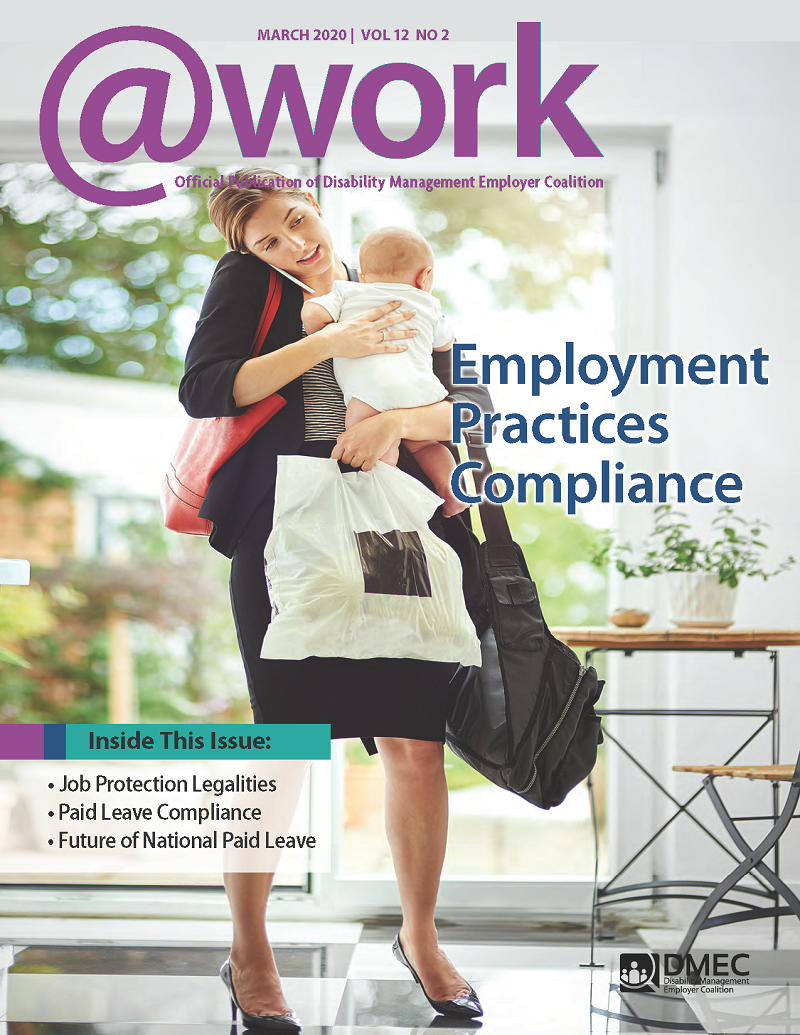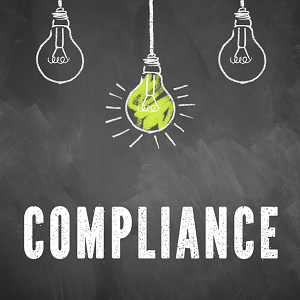
March 2020
Employment Practices Compliance
The rapid development of state and local paid leave laws creates unique challenges for employers as they manage an increasingly complex patchwork of regulations. Diverse eligibility, pay models, job projections, and reporting are just the start. This issue of @Work provides a deep dive into these compliance challenges and offers strategic insight and best practices for your organization.
Features
Job Protection: What Does It Really Mean?
Whether an absence is job-protected is critical to an employee’s and employer’s understanding of the consequences of a leave. Most of the common laws that support a leave of absence contain explicit job protection, though the details of that obligation vary. Read more.

Compliance in the Ever-Changing Paid Leave Environment
Enactment of new paid leave laws by state and local jurisdictions is on the rise, and these laws are challenging organizations, large and small. Employers need to be able to implement diverse new leave mandates. Read more.

Will Federal Employee Paid Leave Lead to a National Private Sector Mandate?
Effective October 2020, civilian federal employees will be entitled to 12 weeks of paid parental leave. With this development, could similar legislation be around the corner for the rest of the U.S. workforce? Supporters of paid leave are optimistic. Read more.

Spotlight Articles
Program Showcase: Designing PFML
Paid family and medical leave (PFML) is an increasingly popular employee benefit, and more states are adopting paid leave legislation. The trends and complexities of managing leave continue to grow, and employers are exploring how to best implement PFML programs. Read more.

Program Showcase: RTW & Accommodation
As employers develop program links between workers' compensation, non-occupational disability, and leave, the ADA fits into the partnership. Recognizing this, many third-party administrators and insurance carriers have added ADA accommodation to their menu of services. Read more.

Columns
Absence Matters: Compliance Strategy
Unlike the clearly-defined FMLA, the ADA does not limit or quantify leaves. Conflicts among recent court rulings illustrate that remaining current and up to date on compliance matters is essential. Read more.

Integrated Absence Management: Coordination of Benefits
In today’s environment, a single absence event often triggers an employee’s eligibility for multiple leave and benefit programs. Employers must coordinate paid and unpaid programs, whether government-mandated or employer-sponsored, to determine an employee’s leave allowance and potential wage continuation. Read more.

Engaging Today’s Workforce: FMLA Compliance Changes
The FMLA provides up to 12 weeks of unpaid, protected leave for eligible employees, giving workers an important element of job security during difficult times. While this sounds simple on the surface, the FMLA is quite complex, partly due to changing legal interpretations of the law. Read more.

Employer Solutions: Parental Leave Policy
After one large employer introduced a flexible 18-week paid parental leave policy in 2017, their number of men using the benefit more than doubled. This employer’s policy allowed parents to take the leave for one continuous period or in smaller bites, which resonated with fathers. Read more.

FMLA & ADA Medical Information: Effective Medical Inquiry
Understanding the proper way to obtain appropriate medical support for an employee’s request for accommodation under the ADA can challenge even the most seasoned disability professional. In general, the ADA prohibits medical examinations and inquiries unless they are job-related and consistent with business necessity. Read more.

IAM Technology Tips: State-Administered PFML
Carriers, third-party administrators, and employers often use different systems and teams to manage employer-funded disability insurance versus state-administered insurance versus state-mandated job protection versus accommodations, voluntary insurance, and the list goes on. But it’s all one absence journey to the employee. Read more.

Absence & Accommodation Technology: “Must Have” Features
With new solutions coming on the market regularly, employers have a lot of options to digest when selecting the right leave management technology. Let’s investigate which features to prioritize when compiling your leave management must-haves. Read more.

Common Sense Compliance: FMLA & ADA Case Law
You don’t have to wind up in the courtroom yourself to learn valuable take-aways from Family and Medical Leave Act and Americans with Disabilities Act litigation. Here are some common sense lessons from recent cases. Read more.

A Clinician’s Viewpoint: Job Description Apps
Employers are constantly struggling to do more with less to stay competitive while supporting employee engagement. Effectively managing absence helps employers achieve a bigger return on investment, and key to containing absence is the use of job descriptions to help manage return to work. Read more.

Workplace Mental Health: Is Your Organization Ready?
Driven by the high cultural and workplace visibility of mental health, many employers are examining compliance issues. This is timely because mental health conditions are common and potentially costly for employers, affecting nearly one in five American adults. Read more.

Benefits & Risk Management: Maximum Medical Improvement
The onset of an episode of disability, work-related or not, is usually pretty clear. Determining when an episode ends — and its impact on return-to-work expectations — can be much more complex. A great deal can hinge on the determination of “maximum medical improvement”. Read more.

Departments
The CEO's Desk: Mission Compliance
DMEC and its members are strongly unified in our desire to build compliant workplaces that address the fragmented environment of proliferating leave mandates at the federal, state, county, and municipal levels. Read more.

DMEC News: January 2020
For nine years DMEC and Spring Consulting Group have partnered to conduct annual research on employer leave management. The 2019 report highlights trends and employer perspectives on regulatory leaves, non-regulatory leaves, and state paid leave programs. Read more.

Compliance Memos: March 2020
The March 2020 compliance memos cover a new Tennessee state employee paid leave program as well as lessons learned from age discrimination and pay calculation cases. Read more.




